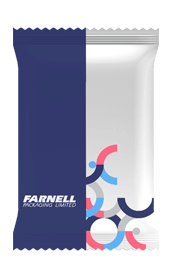If you’re like most people, when you hear “sustainable packaging,” your first thought is probably “recyclable.” Recyclable packaging is a major component of sustainable packaging, but it isn’t the end of the story. New sustainable packaging materials come on the market every year, and each has its own strengths and best use cases. Here are a few of the options for sustainable packaging materials that we often work with at Farnell Packaging.
Recycle-Ready Packaging
At its most basic, recyclable plastic packaging is just any plastic that can be recycled at a standard municipal recycling facility so that its components can be re-used. Here at Farnell Packaging, we firmly believe that recyclable plastic is a necessary part of the sustainable packaging future. All of the packaging we produce can be recycle-ready, and we generally encourage our customers to take this approach.
Nearly all plastic packaging is recycle-ready if it’s made out of a single plastic material type. We call this monomaterial packaging. Packaging made out of a number of different materials is called multimaterial packaging and is more difficult to recycle because the plastic types are not compatible and must be separated before recycling. Generally, companies use multimaterial packaging because they require specific barrier and structural properties that come from these additional materials.
Our film and structure design is focused on developing products that give you the protection and barrier properties previously only found in multimaterial structures in a recycle-ready monomaterial format. If you’re interested in moving from multimaterial to monomaterial packaging to improve recyclability, we will help you find a solution that allows your packaging to be recycled without compromising your requirements.
Post-Industrial and Post-Consumer Films
These films are the next step forward in sustainability. In addition to being recyclable themselves, post-industrial and post-consumer films are themselves produced from recycled materials. What’s the difference?
Post-Industrial film is produced from plastic waste that is the result of other industrial plastic manufacturing. Companies that are concerned about generating plastic waste can turn to post-industrial film as a great opportunity to make strides in that area. At Farnell, we collect all plastic scrap materials from our manufacturing process and grind them into plastic pellets to be turned into post-industrial film, which eliminates nearly all the waste from our manufacturing facility. Learn more about the efforts we’re taking to improve our own sustainability.
Post-Consumer film (often called “Post-Consumer Resin” or PCR) is reclaimed plastic, much like post-industrial film. However, rather than being sourced from industrial waste, PCR films are the end result of consumer plastic recycling programs that take plastics and convert them into a form where they can be re-used. PCR packaging is a popular choice because it directly addresses the problem of plastic waste in the environment, and it’s a key component in what is referred to as the circular economy.
Both post-industrial and post-consumer films are themselves fully recyclable.
Degradable Films
Degradable films have only recently begun to be used in food and other consumer packaging. They are another possible solution to the problem of plastic waste pollution, because they are designed to break down rather than persist in the environment for many years like traditional plastic that isn’t properly recycled can. At Farnell Packaging, we work with two main categories of degradable films.
Compostable film functions the same way as traditional plastic films, but it’s designed to break down into organic compounds that will actually add value to the soil. In many cases, compostable films can be disposed of in municipal composting facilities, where they will eventually add value to nearby farms or community gardens.
Landfill degradable film also breaks down, but cannot be composted. Instead, when it’s in a landfill environment, it will be consumed by microbes and converted into gas, which can then be re-captured by Landfill Gas Capture facilities and turned into energy. In these environments, landfill degradable film contributes 19 times more energy than regular plastic.
However, where both of these materials are relatively new, sometimes local regulations don’t permit their use in municipal facilities. If you’re considering degradable films, talk to us and we’ll help you choose a film that is right for you and your application.
Bio-Based Films
Bio-based films are packaging films created from biological resources or plants — for example, sugarcane. These films are chemically identical to standard polyethylene films, and can be recycled in the same manner. Interestingly, bio-based films are actually carbon positive, meaning that they remove more carbon dioxide from the atmosphere than they add. This is possible because as the growing plants undergo photosynthesis, they consume more carbon dioxide than is produced from emissions during the manufacturing process.
Bio-based films can be an excellent choice for companies that are concerned about reducing their carbon emissions and fighting climate change. If you’re considering bio-based films, let us know and we’ll help you work out the most sustainable solution for your needs.
Developing Sustainable Packaging Pathways
Every company and product has different packaging needs, so the journey towards more sustainable packaging is different for everyone. At Farnell Packaging, we are passionate about our mission to help our partners find the sustainable packaging solutions that are right for them and for their customers.
We’ve put together a brief guide that contains some additional information about sustainable packaging materials, as well as some other thoughts to consider as you and your company take your next steps toward a more sustainable future.

